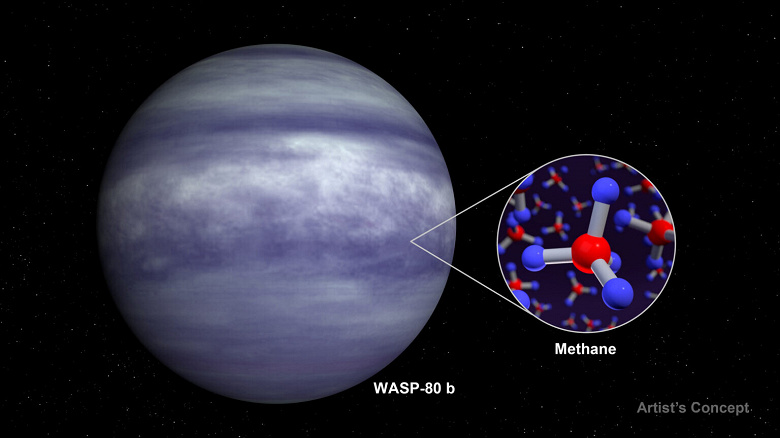Detection of the presence of methane in the atmosphere of the exoplanet WASP-80 b is a significant discovery
For a long time, methane was not found in the atmospheres of exoplanets, unlike water vapor, which was found in the atmospheres of more than ten exoplanets. At the same time, methane is widespread in the atmospheres of the gas giants of our solar system, such as Jupiter, Saturn, Uranus and Neptune.
The discovery belongs to scientists from NASA and Arizona State University. WASP-80 b (with a temperature of about 825 Kelvin) is a “hot Jupiter” – meaning that the planet is similar in size and mass to Jupiter, but its temperature is somewhere between the temperature of hot Jupiters (for example, the planet HD 209458 b with a temperature of 1450 K) and cold Jupiters, where the temperature is about 125 K.
WASP-80 b orbits the red dwarf every three days and is located 163 light-years away in the constellation Aquila. Due to the close distance between the planet and its star, and the distance of both objects from us, we cannot see this planet directly even with modern telescopes, including the James Webb. Instead, the researchers study the combined light from the star and planet using the transit method (which is commonly used to detect exoplanets) and the eclipse method.
The transit method allows you to observe the system at the moment when the planet passes in front of the star. At this time, the atmospheric shell of the planet is illuminated by the star along its day and night boundaries. At certain wavelengths where molecules in a planet's atmosphere absorb light, the atmosphere becomes denser and blocks more starlight, resulting in deeper dimming compared to other wavelengths where the atmosphere allows light to pass through. This method allows scientists to determine the composition of a planet's atmosphere by determining which spectral lines are blocked.
The eclipse method, on the other hand, allows the system to be observed as the planet passes behind its star. This causes another small drop in the overall luminosity graph. Analysis of eclipse spectra allows us to determine which molecules in the planet's atmosphere absorb light at certain wavelengths.
The initial observations were transformed into spectra that show how the planet's atmosphere interacts with different wavelengths of light. Two types of models were used to interpret these spectra. One model was flexible and included different combinations of methane, water and temperature to determine the best fit to the observed data. Another model used existing data on the physics and chemistry of exoplanets to estimate expected levels of methane and water.
Both types of models led to the same thing: the detection of methane. To ensure the correctness of the results, scientists used statistical methods and assessed the probability of methane being detected by chance. The results exceeded the 5 Sigma gold standard, meaning the likelihood of a false methane detection is very low.
This result makes it possible to compare the planets of the Solar System with planets beyond it. And James Webb will provide a more complete picture of WASP-80 b's atmosphere and study the content of other substances, such as carbon monoxide and carbon dioxide.

